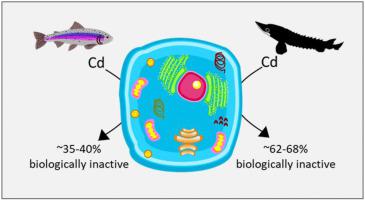Chemosphere ( IF 8.1 ) Pub Date : 2020-12-01 , DOI: 10.1016/j.chemosphere.2020.129142 Kamran Shekh , Huzaifa Saeed , Vladimir Kodzhahinchev , Markus Brinkmann , Markus Hecker , Som Niyogi

|
Recent studies have shown that white sturgeon (Acipenser transmontanus) are more resistant to cadmium (Cd) compared to rainbow trout (Oncorhynchus mykiss), whereas they are more sensitive than rainbow trout when exposed to copper (Cu). Differences in the subcellular distribution of metals among species could be one of the factors responsible for the differences in the sensitivity to metals. Although, subcellular distribution has been studied extensively in many species with many metals, its direct role in species-specific differences in the sensitivity has not been well studied. The objective of this study was to evaluate the role of subcellular distribution of metals in species-specific differences in the sensitivity to metals between sturgeon and trout. We compared the subcellular distribution of metals Cd and Cu in the cellular debris, heat-stable proteins, heat-denatured fraction, metal-rich granules, and organelles fractions from the gills and liver after exposure of juveniles of both species to 1.25 and 20 μg/L Cd and Cu for 8 days, respectively. Sturgeon diverted a higher amount of Cd towards biologically inactive metal pool (BIM) and a lower amount towards the biologically active metal pool (BAM) compared to trout in both tissues. This explained why sturgeon are able to tolerate a relatively higher exposure level to Cd compared to trout. For Cu, there was no statistically significant species-specific differences in the amounts diverted towards either BAM or BIM; hence, white sturgeon’s greater sensitivity to Cu was not explained by its subcellular distribution strategies.
中文翻译:

白urge(Acipenser transmontanus)和虹鳟(Oncorhynchus mykiss)的ill和肝脏中镉和铜的亚细胞分布差异。
最近的研究表明,与虹鳟鱼(Oncorhynchus mykiss)相比,白色st鱼(Acipenser transmontanus)对镉(Cd)的抵抗力更高。),而当它们暴露于铜(Cu)时比虹鳟更敏感。物种间金属亚细胞分布的差异可能是导致对金属敏感性差异的因素之一。尽管亚细胞分布已经在许多具有多种金属的物种中进行了广泛的研究,但是其对物种特异性敏感性差异的直接作用尚未得到很好的研究。这项研究的目的是评估st细胞和鳟鱼之间金属亚细胞分布在物种特异性差异中对金属敏感性的作用。我们比较了细胞碎片,热稳定蛋白,热变性级分,富金属颗粒中金属Cd和Cu在亚细胞中的分布,两种幼鱼分别暴露于1.25和20μg/ L Cd和Cu 8天后,来自腮和肝脏的细胞和细胞器级分。与鳟鱼在两个组织中相比,鱼将较高量的Cd转移至生物惰性金属池(BIM),并将较低量的Cd转移至生物活性金属池(BAM)。这就解释了为什么st鱼比鳟鱼能承受相对较高的镉暴露水平。对于铜,转向BAM或BIM的数量在统计学上没有物种特异性的差异;因此,白st鱼对铜的更高敏感性不能通过其亚细胞分布策略来解释。与鳟鱼在两个组织中相比,鱼将较高量的Cd转移至生物惰性金属池(BIM),并将较低量的Cd转移至生物活性金属池(BAM)。这就解释了为什么st鱼比鳟鱼能承受相对较高的镉暴露水平。对于铜,转向BAM或BIM的数量在统计学上没有物种特异性的差异;因此,白st鱼对铜的更高敏感性不能通过其亚细胞分布策略来解释。与鳟鱼在两个组织中相比,鱼将较高量的Cd转移至生物惰性金属池(BIM),并将较低量的Cd转移至生物活性金属池(BAM)。这就解释了为什么st鱼比鳟鱼能承受相对较高的镉暴露水平。对于铜,转向BAM或BIM的数量在统计学上没有物种特异性的差异;因此,白st鱼对铜的更高敏感性不能通过其亚细胞分布策略来解释。











































 京公网安备 11010802027423号
京公网安备 11010802027423号